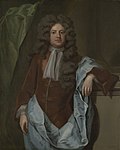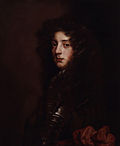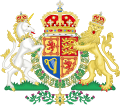| Minister | Birth | Death | Formal office(s) | Monarch |
|---|
Dunstan,
Archbishop of Canterbury
946–955 | | c. 920, near Glastonbury
Son of Thegn Heorstan and Cynethryth | 19 May 988 | Treasurer
Chancellor | Eadred
(946–955) |
| No informal holder; personal rule of King Eadwig (955–959) |
Dunstan,
Archbishop of Canterbury
959–978 | | c. 920, near Glastonbury
Son of Thegn Heorstan and Cynethryth | 19 May 988 | Chancellor | Edgar
(959–975) |
| No informal holder (978–1021) |
Godwin,
Earl of Wessex
1022–1053 | | c. 988, England
Son of Wulfnoth Cild | 15 April 1053 | Justiciar
Treasurer | Cnut (1016–1035)
Harold I (1035–1040)
Harthacnut (1040–1042)
Edward the Confessor (1042–1066) |
Harold,
Earl of Wessex
1053–1066 | 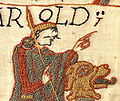 | c. 1022, England
Son of Godwin, Earl of Wessex and Gytha Thorkelsdóttir | 14 October 1066 | — |
| No informal holder; personal rule of King William I (1066–1087) |
Ranulf Flambard,
Bishop of Durham
1089–1100 | | c. 1060, near Bayeux
Son of Thurstin | 5 September 1128, Durham | Treasurer
Justiciar
Keeper of the Great Seal | William II
(1087–1100) |
Roger,
Bishop of Salisbury
1100–1135 | | c. 1070-1080, Normandy
| 11 December 1139, Salisbury | Lord Chancellor
Justiciar | Henry I
(1100–1135) |
Thomas Becket,
Archbishop of Canterbury
1155–1162 |  | 21 December 1118, London
Son of Gilbert
and Matilda Beket | 29 December 1170, Canterbury | Lord Chancellor | Henry II
(1154–1189) |
| No informal holder; personal rule of king Henry II (1162–1189) |
William de Longchamp,
Bishop of Ely
1190–1191 | | Normandy
Son of Hugh de Longchamp
and Eve de Lacy | January 1197 Poitiers | Justiciar
Lord Chancellor | Richard I
(1189–1199) |
Walter de Coutances,
Archbishop of Rouen
1191–1194 | | Cornwall
Son of Reinfrid
and Gonilla | 16 November 1207 | Justiciar |
| No informal holder; personal rule of King Richard I (1194–1199) |
William Marshal,
1st Earl of Pembroke
1213–1216 | | c. 1145, Wiltshire
Son of John Marshall and Sybilla of Salisbury | 14 May 1219, Caversham | Lord Marshal | John
(1199–1216) |
William Marshal,
1st Earl of Pembroke
1216–1219 | | c. 1145 Wiltshire
Son of John Marshall and Sybilla of Salisbury | 14 May 1219, Caversham | Regent
Lord Marshal | Henry III
(1216–1272) |
Hubert de Burgh,
Earl of Kent
1219–1232 | | c. 1175, Norfolk
Son of Reyner de Burgh | c. 5 May 1243, Banstead | Regent
(1219–1227)
Justiciar |
Peter des Roches,
Bishop of Winchester
1232–1234 | | — | 9 June 1238 | — |
| Personal rule (1234–1258); Council of Fifteen (1258–1261); Personal rule (1262–1264) |
Simon de Montfort,
6th Earl of Leicester
1264–1265 | | c. 1208, Montfort-l'Amaury
Son of Simon de Montfort,
5th Earl of Leicester and Alix de Montmorency | 4 August 1265, Evesham | Lord High Steward
Protector of the Realm |
| No informal holder; personal rule of King Henry III (1265–1272) |
| Regents: Walter Giffard , Roger Mortimer , and Robert Burnell (1272–1274) | Edward I
(1272–1307) |
Robert Burnell,
Bishop of Bath and Wells
1274–1292 | | c. 1235, Acton Burnell
Son of Robert Burnell | 25 October 1292, Berwick-upon-Tweed | Lord Chancellor |
John de Stratford ,
Archbishop of Canterbury
1330–1340 | |
William of Wykeham ,
Bishop of Winchester
1367–1371 | |
William of Wykeham ,
Bishop of Winchester
1389–1391 | |
| Minister | Birth | Death | Formal office(s) | Monarch |
|---|
Henry Beaufort ,
Cardinal Bishop of Winchester
1413–1417 |  | 1375
Son of John of Gaunt and Katherine Swynford | 11 April 1447, Wolvesey Castle
Aged 71–72 | Lord Chancellor | Henry V
(1413–1422) |
| No informal holder; personal rule of king Henry V (1417–1422) |
John of Lancaster,
Duke of Bedford
1422–1435
&
Humphrey, Duke of Gloucester
1422–1437 See Regency government, 1422–1437 | 
 | 1389
Son of Henry Bolingbroke and Mary de Bohun
1390
Son of Henry Bolingbroke and Mary de Bohun | 14 September 1435, Rouen
Aged 46,
23 February 1447, Bury St Edmunds
Aged 56 | Lord Protector
(Jointly)
Constable of England
(Bedford, possibly)
Regent of France
(Bedford)
&
Lord Warden of the Cinque Ports
(Gloucester)
Justice in Eyre south of Trent
(Gloucester) | Henry VI
(1422–1461) |
Henry Beaufort ,
Cardinal Bishop of Winchester
1437–1447 |  | 1375
Son of John of Gaunt and Katherine Swynford | 11 April 1447, Wolvesey Castle
Aged 71–72 | — |
William de la Pole,
1st Duke of Suffolk
1447–1450 |  | 1375
Son of Michael de la Pole, 2nd Earl of Suffolk and Katherine de Stafford | 2 May 1450, English Channel
Aged 53 | Lord High Admiral |
| No informal holder; personal rule of king Henry VI (1450–1454) |
Richard of York,
3rd Duke of York
1454–1455 |  | 1411
Son of Richard of Conisburgh and Anne Mortimer | 30 December 1460, Sandal Magna
Aged 49 | Lord Protector
Lieutenant of Ireland |
| No informal holder; personal rule of king Henry VI (February 1455–November 1455) |
Richard of York,
3rd Duke of York
1455–1456 |  | 1411
Son of Richard of Conisburgh and Anne Mortimer | 30 December 1460, Sandal Magna
Aged 49 | Lord Protector
Lieutenant of Ireland |
| No informal holder; personal rule of king Henry VI (1460–1461) |
Richard Neville,
16th Earl of Warwick
"Warwick the Kingmaker""
1461–1467 | 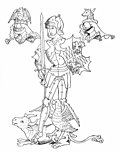 | 1428, England
Son of Richard Neville, 5th Earl of Salisbury and Alice Montacute, 5th Countess of Salisbury | 14 April 1471, Battle of Barnet
Aged 42 | Lord High Admiral
Captain of Calais
Steward of the Duchy of Lancaster
Lord Warden of the Cinque Ports | Edward IV
(1461–1470) |
| No informal holder; personal rule of king Edward IV (1467–1470) |
Richard Neville,
16th Earl of Warwick
"Warwick the Kingmaker"
1470–1471
(Readeption of Henry VI) |  | 1428, England
Son of Richard Neville, 5th Earl of Salisbury and Alice Montacute, 5th Countess of Salisbury | 14 April 1471, Battle of Barnet
Aged 42 | Lord High Admiral
Captain of Calais
Lord Warden of the Cinque Ports | Henry VI
(1470–1471) |
| No informal holder; personal rule of king Edward IV (1471–1475) | Edward IV
(1461–1470, 1471–1483) |
Thomas Rotherham,
Bishop of Lincoln
1475–1483 | 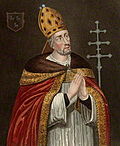 | 1423, England
Son of Thomas Rotherham and Dame Alice Rotherham | 29 May 1500, Cawood Castle
Aged 76 | Keeper of the Privy Seal
Lord Chancellor |
Richard,
Duke of Gloucester
30 April 1483–25 June 1483 |  | 1452, England
Richard of York and Cecily Neville | 22 August 1485, Bosworth Field
Aged 32 | Lord Protector of the Realm | Edward V
(9 April 1483–25 June 1483) |
Thomas Stanley,
1st Earl of Derby
1485–1504 |  | 1435, England
Son of Thomas Stanley, 1st Baron Stanley and Joan Goushill | 29 July 1504, Lancashire
Aged 68–69 | Lord High Constable | Henry VII
(1485–1509) |
Richard Empson
&
Edmund Dudley
1505–1509 |  | 1450, England
Son of Peter Empson
and Elizabeth Joseph
1462 or 1471, England
Son of John Dudley
and Elizabeth Bramshot | 17 August 1510, Tower Hill
Executed for treason
Aged 59–60 and 39–47
(respectively) | Chancellor of the Duchy of Lancaster
(Empson)
&
President of the King's Council
(Dudley) |
| No informal holder; personal rule of king Henry VIII (1509–1514) | Henry VIII
(1509–1547) |
Cardinal Thomas Wolsey,
Archbishop of York
1514–1529 |  | March 1473, Ipswich
Son of Robert Wolsey
and Joan Daundy | 29 November 1530, Leicester
Aged 57 | Lord Chancellor
Papal Legate in England |
Thomas More
1529–1532 |  | 7 February 1478, London
Son of John More and Agnes Graunger | 6 July 1535, Tower Hill
Executed for treason
Aged 57 | Lord Chancellor |
Thomas Cromwell,
1st Earl of Essex (1540)
1532–1540 |  | 1485, Putney
Son of Walter Cromwell
and Katherine Williams | 28 July 1540, Tower Hill
Executed for treason
Aged 54–55 | Chancellor of the Exchequer
Lord Privy Seal
Secretary of State
Master of the Rolls
Clerk of the Hanaper
Master of King's Jewel House
Lord Great Chamberlain
Governor of the Isle of Wight
Surveyor of the King's Woods
Trier/Receiver of Petitions in the Lords
Warden and Chief Justice in Eyre, North of Trent |
Thomas Howard,
3rd Duke of Norfolk
1540–1546 | 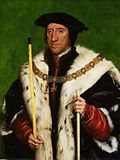 | 1473, England
Son of Thomas Howard, 2nd Duke of Norfolk and Elizabeth Tilney, Countess of Surrey | 25 August 1554, Kenninghall
Aged 80–81 | Lord High Treasurer
Earl Marshal
Lieutenant-General of the army |
Edward Seymour,
1st Duke of Somerset
1547–1549 |  | 1500, England
Son of John Seymour and Margery Wentworth | 22 January 1552, Tower Hill
Executed for treason
Aged 50–51 | Lord Protector of the Realm
Lord High Treasurer
Earl Marshal | Edward VI
(1547–1553)
and
Jane
(1553) |
John Dudley,
1st Earl of Warwick
then 1st Duke of Northumberland
1549–1553 |  | 1504, London
Son of Edmund Dudley and Elizabeth Grey | 22 August 1553, Tower Hill
Executed for treason
Aged 48–49 | Lord Great Chamberlain
Lord President of the Council
Grandmaster of the Household |
Stephen Gardiner,
Bishop of Winchester
1553–1555 |  | 1483, Bury St Edmunds
Son of John or William Gardiner
and Ellen/Helen Tudor | 12 November 1555, London
Aged 71–72 | Lord Chancellor | Mary I
(1553–1558) |
Cardinal Reginald Pole,
Archbishop of Canterbury
1555–1558 |  | 3 March 1500, Stourton
Son of Richard Pole and Margaret Pole, Countess of Salisbury | 17 November 1558, London
Aged 58 | Papal Legate to England |
William Cecil,
1st Baron Burghley
1558–1598 |  | 13 September 1520, Bourne
Son of Richard Cecil and Jane Heckington | 4 August 1598, Westminster
Aged 77 | Lord High Treasurer
Lord Privy Seal
Secretary of State | Elizabeth I
(1558–1603) |
Robert Cecil
1598–1603 | 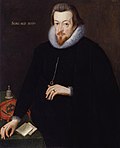 | 1563, Westminster
Son of William Cecil, 1st Baron Burghley and Mildred Cooke | 24 May 1612, Marlborough, Wiltshire
Aged 48 | Lord Privy Seal
Secretary of State
Chancellor of the Duchy of Lancaster |
Robert Cecil,
Baron Cecil
then (1605)
1st Earl of Salisbury
1603 – 1612 |  | 1 June 1563, Westminster
Son of William Cecil, 1st Baron Burghley and Mildred Cooke | 24 May 1612, Marlborough
Aged 48 | Lord High Treasurer
Lord Privy Seal | James I
(1603–1625) |
Henry Howard,
1st Earl of Northampton
1612 – 1614 |  | 25 February 1540, Shotesham
Son of Henry Howard, Earl of Surrey and Frances de Vere | 15 June 1614, Westminster
Aged 74 | First Lord of the Treasury
Lord Privy Seal |
Robert Carr,
1st Earl of Somerset
1614 – 1615 |  | c. 1587, Wrington
Son of Thomas Kerr (Carr)
and Janet Scott | 17 July 1645, Dorset
Aged 57–58 | Lord Warden of the Cinque Ports
Lord Chamberlain
Lord Privy Seal |
| No informal holder; personal rule of king James I (1615–1617) |
Francis Bacon,
Baron Verulam (1618)
1617 – 1621 | 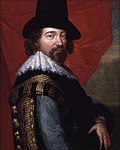 | 22 January 1561, Strand, London
Son of Nicholas Bacon and Anne Cooke | 9 April 1626, Highgate
Aged 65 | Lord Chancellor |
George Villiers,
ennobled (1623)
1st Duke of Buckingham
1623 – 1628 |  | 28 August 1592, Brooksby
Son of George Villiers and Mary Beaumont | 23 August 1628, Portsmouth
Assassinated by John Felton
Aged 35 | Lord Warden of the Cinque Ports
Lord High Admiral
Master of the Horse |
Charles I
(1625–1649)
Since 1642 in
status of civil war |
Richard Weston,
Baron Weston
then 1st Earl of Portland
1628 – 1634/35 |  | 1 March 1577, Essex
Son of Jerome Weston
and Mary Cave | 13 March 1634/35, Westminster
Aged 57/58 | Lord High Treasurer
First Lord of the Admiralty |
| No informal holder; personal rule of king Charles I (1635–1640) |
Thomas Wentworth,
1st Earl of Strafford
1640 – 1641 |  | 13 April 1593, London
Son of William Wentworth
and Anne Atkins | 12 May 1641, Tower Hill
Executed for conspiracy
Aged 48 | Lord Lieutenant of Ireland |
Robert Bertie,
1st Earl of Lindsey
1641 – 1642 |  | 16 December 1582, England
Son of Peregrine Bertie and Mary de Vere | 24 October 1642, Battle of Edgehill
Aged 59 | Lord Great Chamberlain |
Prince Rupert,
Count Palatine of the Rhine
1642 – 1646 |  | 17 December 1619, Prague
Son of Frederick V, Elector Palatine and Elizabeth Stuart | 29 November 1682, Westminster
Aged 62 | — |
| Imprisonment of king Charles I until his execution (1646–1649) |







































